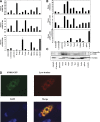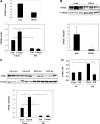Identification of sucrose non-fermenting-related kinase (SNRK) as a suppressor of adipocyte inflammation
- PMID: 23520131
- PMCID: PMC3712026
- DOI: 10.2337/db12-1081
Identification of sucrose non-fermenting-related kinase (SNRK) as a suppressor of adipocyte inflammation
Abstract
In this study, the role of sucrose non-fermenting-related kinase (SNRK) in white adipocyte biology was investigated. SNRK is abundantly expressed in adipose tissue, and the expression level is decreased in obese mice. SNRK expression is repressed by inflammatory signals but increased by insulin sensitizer in cultured adipocytes. In vivo, adipose tissue SNRK expression can be decreased by lipid injection but enhanced by macrophage ablation. Knocking down SNRK in cultured adipocytes activates both JNK and IKKβ pathways as well as promotes lipolysis. Insulin-stimulated Akt phosphorylation and glucose uptake are impaired in SNRK knockdown adipocytes. Phosphoproteomic analysis with SNRK knockdown adipocytes revealed significantly decreased phosphorylation of 49 proteins by 25% or more, which are involved in various aspects of adipocyte function with a clear indication of attenuated mTORC1 signaling. Phosphorylation of 43 proteins is significantly increased by onefold or higher, among which several proteins are known to be involved in inflammatory pathways. The inflammatory responses in SNRK knockdown adipocytes can be partially attributable to defective mTORC1 signaling, since rapamycin treatment activates IKKβ and induces lipolysis in adipocytes. In summary, SNRK may act as a suppressor of adipocyte inflammation and its presence is necessary for maintaining normal adipocyte function.
Figures






Similar articles
-
Dysregulation of PP2A-Akt interaction contributes to Sucrose non-fermenting related kinase (SNRK) deficiency induced insulin resistance in adipose tissue.Mol Metab. 2019 Oct;28:26-35. doi: 10.1016/j.molmet.2019.07.009. Epub 2019 Aug 2. Mol Metab. 2019. PMID: 31420304 Free PMC article.
-
Inflammation promotes adipocyte lipolysis via IRE1 kinase.J Biol Chem. 2021 Jan-Jun;296:100440. doi: 10.1016/j.jbc.2021.100440. Epub 2021 Feb 19. J Biol Chem. 2021. PMID: 33610548 Free PMC article.
-
Fisetin regulates obesity by targeting mTORC1 signaling.J Nutr Biochem. 2013 Aug;24(8):1547-54. doi: 10.1016/j.jnutbio.2013.01.003. Epub 2013 Mar 18. J Nutr Biochem. 2013. PMID: 23517912
-
Insulin stimulates adipogenesis through the Akt-TSC2-mTORC1 pathway.PLoS One. 2009 Jul 10;4(7):e6189. doi: 10.1371/journal.pone.0006189. PLoS One. 2009. PMID: 19593385 Free PMC article.
-
The multifaceted role of mTORC1 in the control of lipid metabolism.EMBO Rep. 2013 Mar 1;14(3):242-51. doi: 10.1038/embor.2013.5. Epub 2012 Feb 12. EMBO Rep. 2013. PMID: 23399656 Free PMC article. Review.
Cited by
-
Snf1-related kinase improves cardiac mitochondrial efficiency and decreases mitochondrial uncoupling.Nat Commun. 2017 Jan 24;8:14095. doi: 10.1038/ncomms14095. Nat Commun. 2017. PMID: 28117339 Free PMC article.
-
SNRK tames mTOR against metabolic dysfunction-associated steatotic liver disease.Mol Ther. 2025 Jan 8;33(1):28-29. doi: 10.1016/j.ymthe.2024.12.031. Epub 2024 Dec 26. Mol Ther. 2025. PMID: 39729984 No abstract available.
-
Circulating miR-103a-3p contributes to angiotensin II-induced renal inflammation and fibrosis via a SNRK/NF-κB/p65 regulatory axis.Nat Commun. 2019 May 13;10(1):2145. doi: 10.1038/s41467-019-10116-0. Nat Commun. 2019. PMID: 31086184 Free PMC article.
-
Sucrose Non-Fermenting Related Kinase Expression in Ovarian Cancer and Correlation with Clinical Features.Cancer Invest. 2017 Aug 9;35(7):456-462. doi: 10.1080/07357907.2017.1337781. Epub 2017 Jul 19. Cancer Invest. 2017. PMID: 28722495 Free PMC article.
-
Cardiomyocyte-Specific Snrk Prevents Inflammation in the Heart.J Am Heart Assoc. 2019 Nov 19;8(22):e012792. doi: 10.1161/JAHA.119.012792. Epub 2019 Nov 13. J Am Heart Assoc. 2019. PMID: 31718444 Free PMC article.
References
-
- Hotamisligil GS. Inflammation and metabolic disorders. Nature 2006;444:860–867 - PubMed
-
- Rotter V, Nagaev I, Smith U. Interleukin-6 (IL-6) induces insulin resistance in 3T3-L1 adipocytes and is, like IL-8 and tumor necrosis factor-alpha, overexpressed in human fat cells from insulin-resistant subjects. J Biol Chem 2003;278:45777–45784 - PubMed
-
- Tack CJ, Stienstra R, Joosten LA, Netea MG. Inflammation links excess fat to insulin resistance: the role of the interleukin-1 family. Immunol Rev 2012;249:239–252 - PubMed
Publication types
MeSH terms
Substances
Grants and funding
LinkOut - more resources
Full Text Sources
Other Literature Sources
Molecular Biology Databases
Research Materials

